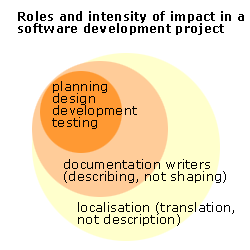Learn more
- Jun 25, 2008
Not a pipeline, but a graph: software development in the KiWi/Sun usecase
Josef Holy‘s report this morning about the status quo in the KiWi usecase conducted in collaboration with Sun microsystem presented us with an interesting contrast. While the point of departure in the Logica usecase was a conceptual model of knowledge that is shaped by CMMI, Josef made the point that software development in an open source project follows quite different rules: “The lack of formal processes IS the process”, said Josef, characterizing the collaboration in the NetBeans development environment which (as reported earlier) has about 200 Sun developers working on it, in addition to thousands of external contributors and hundreds of thousands of active users. Correcting his own presentation regarding the development process from May ’08 he said: “We shouldn’t think of a production pipeline here, but of a graph.”

A first important decision to be made was: Who to involve in the KiWi usecase? As the KiWi approach is decisively informed by the wiki philosophy, it only made sense that the designers, rather than the developers, should participate. Designers need to have access to various repositories of information, for instance user interface specifications, requirements descriptions, usability reports, marketing intelligence data, etc. And, to a much greater extent than is the case with developers, their work relies primarily on the written word, in the form of definition and documentation. And that makes them ideal candidates in the KiWi-Wiki usecase.
P.S: Yes, we all know that documentation is also a crucial part of the work of developers – yet we also know that the world has seen a lot of software developments that went undocumented;-)
